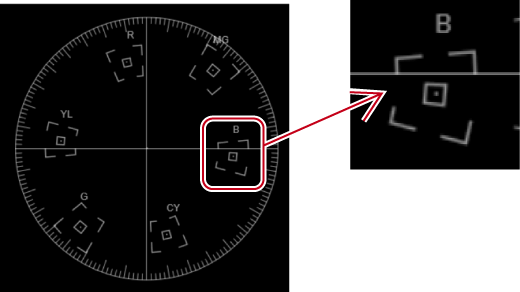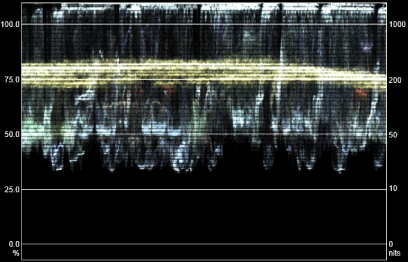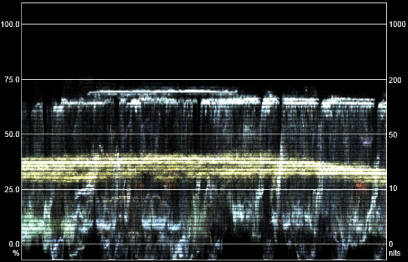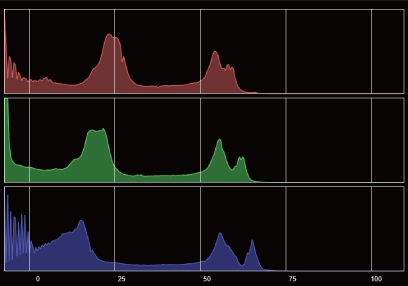Even a video finely displayed on a PC monitor may cause problems like highlight/shadow detail loss when actually displayed on a TV monitor. Although the best solution is to edit the video while checking an environment where the final video is screened or confirming the screening rules, in many cases, editing must be performed without such environment and rules. In such cases, use the vector scope, waveform or histogram to check the brightness and colors of the image displayed in the preview window, and perform the editing process.
Vector scope, waveform and histogram can be used to monitor the brightness and colors, allowing fine adjustment of detailed parts that cannot be seen by eyes.
To check recorder image
1) Move the timeline cursor to display the image to check the color data on Recorder.
2) Click [Toggle Videoscope Display] of the timeline.

The [Videoscope] dialog box appears.
 Alternative
Alternative
Click [View] on the menu bar, and click [Videoscope].
|
|
|---|
|
The following screenshot is an example of the [Videoscope] dialog box divided into four windows.
The conventional analog-based design was changed into a digital-based design.
The conventional [Line] function of [Vector Scope/Waveform] was discontinued.

|
(1) |
Videoscope switching |
Switch the view between vector scope/waveform/histogram. |
|
(2) |
View mode |
Set the display color and zoom ratio of the vector scope, waveform mode (Y/YCbCr/RGB), and display color (Y only).
|
|
(3) |
[Inten]/[Gain] |
Adjust the luminance of the vector scope/waveform, and the gain of histogram. |
|
(4) |
[Scale] |
Adjust the brightness of the scale. |
|
(5) |
Vector scope |
Display the color distribution of the image displayed on the preview window. The circle represents the color circle, and the distance from the center represents the saturation. |
|
(6) |
Showing/hiding sidebar |
Switch show/hide of the sidebar that has information area or other items including [Line Select]. |
|
(7) |
Display view |
Switch the display view between vector scope/waveform/histogram. |
|
(8) |
Waveform |
Display chroma and luminance levels of the image on the preview window. |
|
(9) |
Information area |
Display coordinate values on the screen (X, Y), as well as values of IRE, nits, YCbCr, and RGB. |
|
(10) |
[Line Select] |
Display the information of a Y-axis (vertical) position. Check this item, click
The box shows the Y coordinate value of that position, and the display of the vector scope/waveform/histogram are fixed to the color data of that position. Even after you uncheck the item, the last display of the vector scope/waveform/histogram is reproduced when you check the item box again. |
|
(11) |
[Cursor] |
Add a line with desired luminance level to the waveform and histogram. Select the check box and directly enter the luminance level (unit: nits). An yellow dashed line appears. |
|
(12) |
L/R switch |
In the stereoscopic edit mode, this is displayed when the video of both the L and R sides are displayed in the preview window. The vector scope/waveform/histogram only on the L or R side is displayed. |
|
(13) |
Histogram |
Show the brightness distribution of the image displayed on the preview window by RGB. The horizontal axis indicates brightness, and the vertical axis indicates the number of pixels by color brightness. |
Measure the color balance using a vector scope
Measure the color bar recorded in the source clip using the [Videoscope] dialog box.
For 75% color bar, if the dot indicating color distribution is largely away from the center of
 with [Zoom 100%] display mode setting, the setting may not be appropriate. Check the setting.
with [Zoom 100%] display mode setting, the setting may not be appropriate. Check the setting.

Measure the luminance with waveform to check if it is within the appropriate range
The graduation on the left of the scale (%) indicates the value of IRE. The graduation on the right of the scale (nits) indicates the value of luminance level.
When you place a white color matte clip created in the safe color range on the timeline and measure it in the [Videoscope] dialog box, IRE100 appears. (The position of (1))

In the case of black color matte clips created in the safe color range, IRE0 appears. (at the position of (2)) Adjustment is not necessary when IRE is a minus value.

If the luminance is high, the following screen is displayed.

If the luminance is low, the following screen is displayed.

If IRE needs to be restricted in a range 0% to 100%, see Video Signal Level Restriction .
Video Signal Level Restriction
Measure and check if the brightness distribution is appropriate using the histogram
The graduation under the scale indicates the value of IRE.
Pixels distributed widely without right and left unevenness indicates appropriate brightness.

Pixels are concentrated to the left or right if highlight/shadow detail loss occurs.
Following illustration shows that the pixels are concentrated to the left and shadow detail loss occurs.
